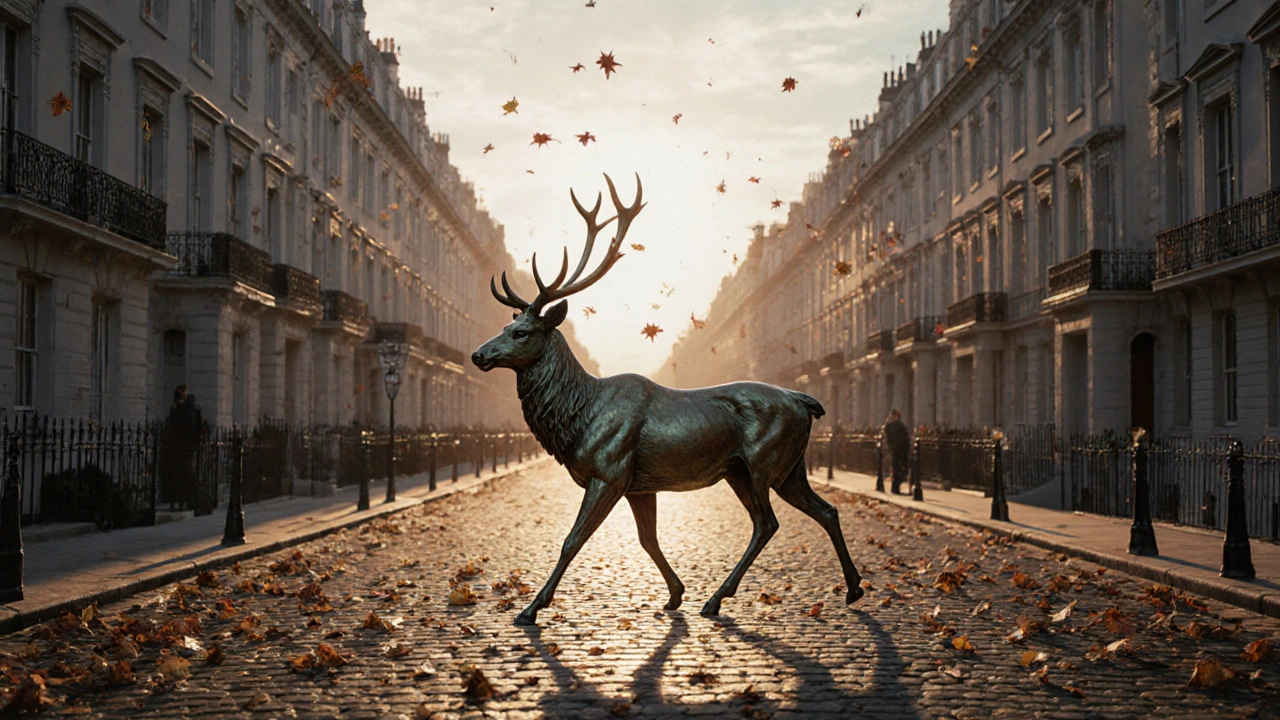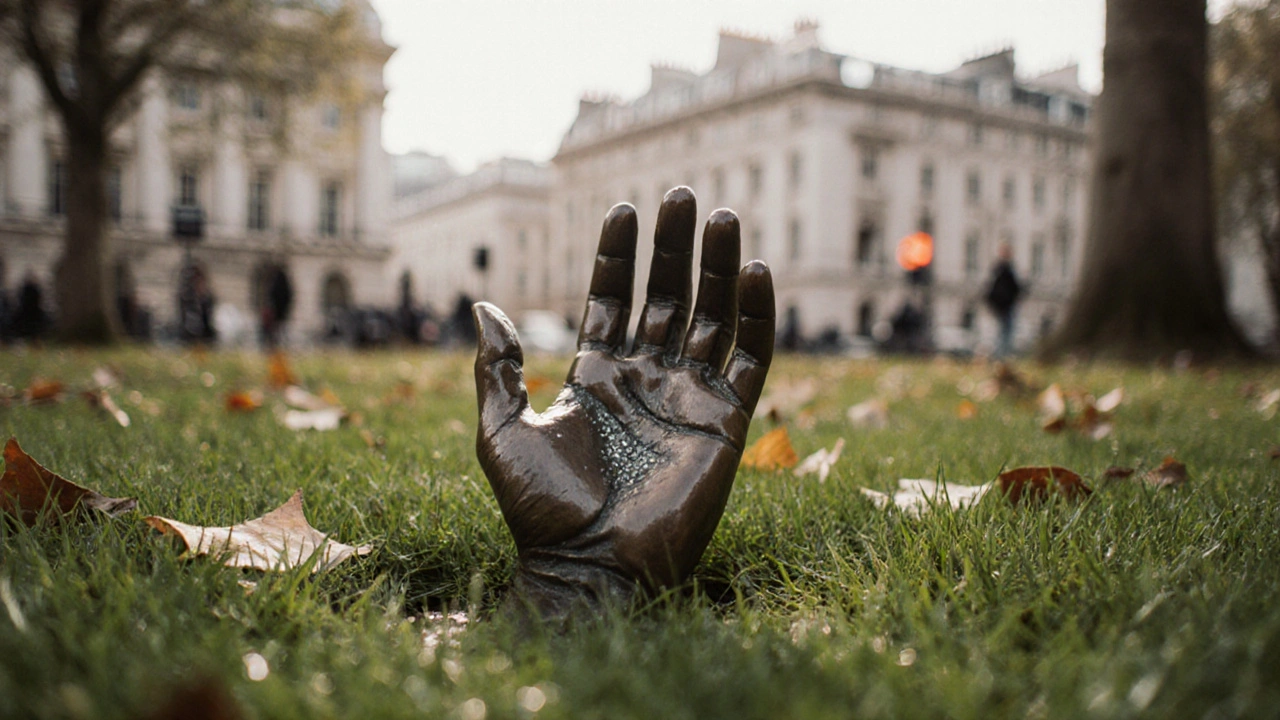
Walking through Mayfair in the late afternoon, you might not expect to stumble upon a 12-foot bronze stag mid-stride, or a floating glass sphere reflecting the sky like a captured cloud. But that’s exactly what happens on the Mayfair sculpture trail. Since 2023, this hidden art route has turned one of London’s most exclusive neighborhoods into an open-air gallery - no ticket needed.
What You’ll Find on the Trail
The trail isn’t marked with signs or maps you can buy. Instead, it’s a loose loop of 14 permanent and rotating installations spread across private courtyards, quiet side streets, and the edges of Mayfair’s famous squares. Most pieces are commissioned by local galleries or private collectors who open their spaces to the public during daylight hours. You won’t find tourist crowds here. Locals know the route. Tourists who find it feel like they’ve uncovered a secret.
One standout is Whispering Roots by Nigerian-British artist Tolu Akindele - a twisted iron tree with hollow branches that hum when the wind blows through them. It sits outside 45 Stratton Street, hidden behind a wrought-iron gate that opens at 9 a.m. daily. Another is Cloud Chamber, a translucent resin sculpture suspended between two townhouse balconies on Brook Street. It shifts color with the light, appearing white at noon and deep blue by sunset.
Not everything is abstract. There’s a life-sized bronze dog named Biscuit by artist Miriam Chen, placed outside the old entrance to the Mayfair Library. Locals say kids leave treats for him. A few have even tied ribbons to his collar. It’s become a small ritual.
How to Navigate the Trail
You don’t need an app. The trail was designed to be found by accident. Start at the corner of Bond Street and Mount Street, where a simple stone plaque embedded in the pavement reads: “Follow the shadows.” That’s your only clue.
From there, walk toward Dover Street. Around the corner, you’ll spot a narrow alleyway with a single bench facing a wall. On the wall? A mirror-polished steel panel that reflects the sky - but only if you stand exactly where the bench sits. Move a step left or right, and the reflection vanishes. This is Still Sky by Japanese artist Ryoji Ikeda.
Each piece is placed so you have to pause, turn, crouch, or look up to see it fully. That’s intentional. The trail isn’t about checking off statues. It’s about slowing down.
Plan for 90 minutes. Most people walk it in two parts: morning light for the reflective and glass pieces, afternoon for the bronze and stone ones. The trail doesn’t change with the seasons, but the quality of light does. Winter mornings give long, sharp shadows. Summer evenings turn the glass sculptures into lanterns.
When to Go
Weekdays are best. Friday through Sunday, the area gets busy with shoppers and private tour groups. If you want quiet, go Tuesday or Wednesday between 10 a.m. and 2 p.m. The sculptures are always accessible, but the private gardens that host some pieces are only open to the public on weekdays.
Don’t come at night. While the sculptures are lit, the courtyards are locked. The trail is meant to be experienced in daylight - when you can see textures, reflections, and how each piece interacts with its surroundings.
Weather matters. Rain turns the bronze pieces dark and glossy. Snow turns the glass ones into icy lanterns. A crisp, clear day makes the reflections pop. A foggy morning turns the trail into a dream.

What Makes This Different From Other Public Art Trails
Most public art trails are curated by city councils. This one isn’t. Mayfair’s trail was started by a group of five art collectors who wanted to bring contemporary sculpture into spaces people pass through every day - but never notice. They didn’t ask for permission. They just placed pieces where they thought they’d matter.
There’s no brochure. No QR codes. No audio guide. You won’t find a gift shop selling postcards of the sculptures. That’s the point. It’s not a tourist attraction. It’s a quiet interruption in daily life.
Compare it to the London Sculpture Walk in Southwark or the Public Art in Hyde Park. Those are big, loud, and designed for crowds. Mayfair’s trail is small, quiet, and meant for one person at a time. It rewards patience. It doesn’t shout. It waits.
What You Should Know Before You Go
Some installations are on private property. You’re allowed to view them, but don’t touch. Don’t climb. Don’t block doorways. The owners aren’t annoyed by visitors - they’re proud of them. But respect matters. These aren’t museum pieces behind ropes. They’re living parts of the neighborhood.
Wear comfortable shoes. The path includes cobblestones, uneven pavement, and narrow walkways. There are no benches along the route, except the ones built into the art itself.
Bring a camera, but not your phone. The best photos come from stepping back, waiting for the light, and looking for reflections. The glass pieces look nothing like they do in photos. You have to see them in person to believe them.
There’s no official end point. The trail loops back on itself. Many people start at Bond Street and end at Berkeley Square, where a single bronze hand reaches out from the grass - palm open, fingers slightly curled. No plaque. No name. Just a hand. Locals say it’s a gesture of welcome. Others say it’s a reminder that art doesn’t need to explain itself.

Why This Matters
Mayfair is one of the most expensive neighborhoods in the world. Property here sells for over £20 million a flat. Yet, in the middle of all that wealth, there’s art that asks nothing. No donation. No ticket. No Instagram post. Just presence.
It’s a quiet rebellion. While the rest of London fills with digital ads and branded experiences, Mayfair’s trail says: Look. Listen. Feel. It doesn’t ask you to share it. It just asks you to notice.
Art doesn’t have to be in a gallery to change how you see the world. Sometimes, it just needs to be where you’re already walking.
Is the Mayfair sculpture trail free to visit?
Yes. All installations are publicly accessible during daylight hours. No tickets, fees, or reservations are required. Some pieces are located in private courtyards, but these are intentionally opened to the public. You’re welcome to walk through, pause, and view them.
How long does it take to walk the entire trail?
Most people take 90 minutes to walk the full loop at a relaxed pace, stopping to view each piece. If you’re in a hurry, you can do it in 45 minutes, but you’ll miss the details. The trail is designed to be experienced slowly - the art rewards patience.
Are the sculptures always on display?
Thirteen of the 14 pieces are permanent. One installation rotates every six months. The current rotating piece is Shadow Echo by artist Lila Nguyen, a series of mirrored panels that shift with the sun’s angle. The next rotation is scheduled for May 2026. Check local art blogs like London Art Diary for updates.
Can I take photos of the sculptures?
Yes, photography is encouraged. But don’t use tripods or professional lighting equipment. Flash is fine for personal use, but avoid blocking walkways or disturbing others. The art is meant to be shared - just don’t turn the trail into a photo shoot.
Are there guided tours available?
No official guided tours exist. The trail was created to be discovered independently. However, some private art consultants offer tailored walking tours for groups. These aren’t advertised publicly and must be arranged in advance through local galleries like the Mayfair Art Collective. Don’t expect to just show up and join one.
What’s the best time of year to visit?
Spring and autumn offer the clearest light for viewing reflective and glass sculptures. Winter brings crisp shadows that highlight texture in bronze and stone. Summer is crowded, and the sun can be too harsh for glass pieces to show their full color. If you want the full experience, aim for late September to early November.
What to Do After the Trail
End your walk at the small café tucked behind Berkeley Square - The Quiet Cup. It doesn’t have a sign. Just a wooden door with a bell. Inside, they serve tea in ceramic mugs and have a shelf of art books about the trail. The owner, a retired sculptor, will sometimes tell you the story behind the hand in the grass if you ask.
There’s no souvenir shop. No postcards. But if you leave with a slower step, a quieter mind, and the memory of a bronze stag standing still in the middle of a busy street - you’ve taken something better than any photo.